The global engine piston ring set market, projected to expand from USD 681.1 million in 2025 to USD 1,196.9 million by 2035 at a CAGR of 5.8%, is shaped not only by production cycles and demand fluctuations but also by evolving distribution trends that influence accessibility and adoption across end-user segments. Distribution networks for piston rings are highly intertwined with the automotive value chain, creating a dynamic flow between OEM supply channels and aftermarket sales.
A major distribution trend is the dual-channel split between OEMs and the aftermarket. Original equipment manufacturers continue to dominate high-volume contracts, ensuring steady integration into new vehicle engines. These partnerships are supported by long-term agreements and supplier consolidation, which stabilize demand despite fluctuations in regional vehicle assembly. The aftermarket, on the other hand, is experiencing rising momentum as replacement cycles remain consistent, particularly in mature vehicle parks in North America and Europe. Independent distributors, specialized retailers, and repair shops form a crucial part of this segment, supported by e-commerce platforms that simplify parts availability. Another key trend is the emergence of digital distribution platforms. With the rise of online B2B and B2C marketplaces, buyers now rely on real-time catalogs, digital verification tools, and compatibility databases to purchase piston rings directly. This reduces reliance on traditional intermediaries, increasing price transparency while accelerating delivery times. Online distribution is especially gaining traction in Asia Pacific, where automotive parts demand is fragmented across numerous local markets, creating opportunities for platform-based logistics solutions.
Regional distribution imbalances are also significant. Asia Pacific leads distribution growth, supported by expanding vehicle manufacturing hubs in China and India, coupled with dense aftermarket demand from large vehicle fleets. Europe and North America rely on structured distribution chains integrated with OEM contracts and certified aftermarket dealers, emphasizing quality standards and compliance. Latin America and Africa remain dependent on import-driven distribution, often challenged by supply delays and higher costs due to weaker logistics infrastructure. Integration into multi-brand distribution ecosystems is another evolving trend. Many piston ring suppliers now bundle products with related engine components such as bearings, liners, and gaskets, positioning themselves as system suppliers rather than single-product vendors. This creates economies of scale and ensures wider acceptance across procurement networks.
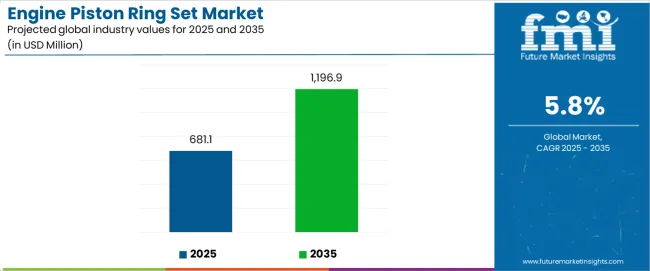
| Period | Primary Revenue Buckets | Share | Notes |
|---|---|---|---|
| Today | Cast iron piston rings (compression, oil control) | 52% | Traditional materials, established engines |
| Steel rings (performance applications) | 31% | High-performance engines, durability focus | |
| Composite rings (specialty applications) | 17% | Aerospace, premium automotive | |
| Future (3-5 yrs) | Advanced cast iron systems | 43-46% | Enhanced surface treatments, precision manufacturing |
| High-performance steel rings | 28-32% | Turbocharged engines, performance applications | |
| Automobile engine applications | 18-22% | Passenger vehicles, commercial vehicles | |
| Marine engine applications | 12-16% | Ship engines, offshore applications | |
| Aerospace engine applications | 8-12% | Aircraft engines, precision requirements | |
| Composite & specialty rings | 6-10% | Advanced materials, specialized applications |
| Metric | Value |
|---|---|
| Market Value (2025) | USD 681.1 million |
| Market Forecast (2035) | USD 1,196.9 million |
| Growth Rate | 5.8% CAGR |
| Leading Materia | Cast Iron Rings |
| Primary Application | Automobile Engine Segment |
The market demonstrates strong fundamentals with cast iron ring systems capturing a dominant share through advanced metallurgical properties and automotive application optimization. Automobile engine applications drive primary demand, supported by increasing performance requirements and automotive industry modernization initiatives. Geographic expansion remains concentrated in developed markets with established automotive infrastructure, while emerging economies show accelerating adoption rates driven by automotive industry modernization initiatives and rising manufacturing standards.
Design for engine performance optimization, not just basic sealing
Primary Classification: The market segments by material type into cast iron, steel, composite, and others, representing the evolution from traditional iron-based rings to sophisticated high-performance alloys for comprehensive engine optimization.
Secondary Classification: Application segmentation divides the market into automobile engines, ship engines, aerospace engines, and others, reflecting distinct requirements for ring performance, durability standards, and operational specifications.
Tertiary Classification: End-use segmentation covers automotive manufacturers, marine engine producers, aerospace companies, industrial equipment manufacturers, and aftermarket suppliers, while distribution channels span OEM supply, aftermarket distributors, and specialized component suppliers.
Regional Classification: Geographic distribution covers North America, Latin America, Western Europe, Eastern Europe, East Asia, South Asia Pacific, and Middle East & Africa, with developed markets leading adoption while emerging economies show accelerating growth patterns driven by automotive industry modernization programs.
The segmentation structure reveals material progression from traditional cast iron rings toward sophisticated steel and composite solutions with enhanced performance capabilities, while application diversity spans from passenger vehicles to aerospace engines requiring precision component solutions.
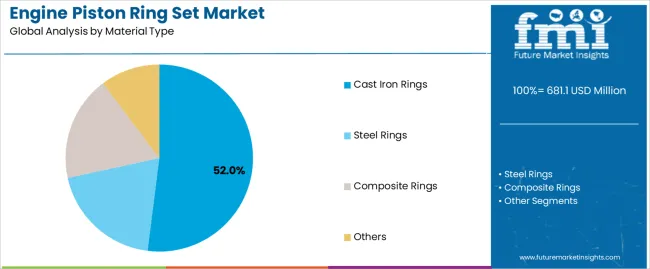
Market Position: Cast iron ring systems command the leading position in the engine piston ring set market with 52% market share through proven metallurgical technologies, including enhanced durability construction, thermal stability properties, and cost-effective manufacturing optimization that enable engine manufacturers to achieve optimal performance across diverse automotive and industrial environments.
Value Drivers: The segment benefits from automotive industry preference for traditional ring systems that provide reliable sealing, proven durability, and operational effectiveness without requiring advanced alloy infrastructure. Enhanced cast iron processing features enable improved wear resistance, thermal management properties, and integration with existing engine programs, where performance reliability and cost optimization represent critical operational requirements.
Competitive Advantages: Cast iron ring systems differentiate through proven performance reliability, established manufacturing processes, and integration with standard engine management systems that enhance facility effectiveness while maintaining optimal operational standards suitable for diverse automotive applications.
Key market characteristics:
Steel ring systems maintain a 31% market position in the engine piston ring set market due to their performance advantages and durability positioning benefits. These materials appeal to facilities requiring high-performance ring solutions with enhanced strength profiles for demanding applications. Market growth is driven by performance engine expansion, emphasizing advanced metallurgical solutions and operational efficiency through optimized durability designs.
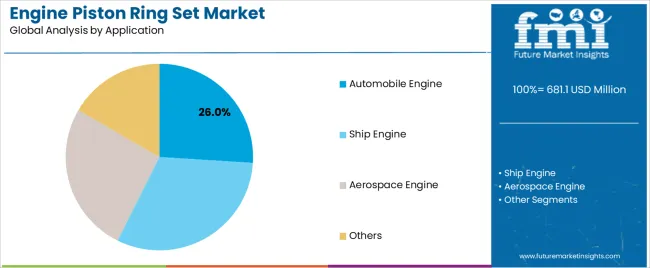
Market Context: Automobile engine applications demonstrate strong growth in the engine piston ring set market with 6.2% CAGR and 26% Industry share due to widespread adoption of advanced engine technologies and increasing focus on fuel efficiency, performance optimization, and emission reduction applications that maximize ring effectiveness while maintaining power output standards.
Appeal Factors: Automotive manufacturers prioritize ring reliability, performance consistency, and integration with existing engine infrastructure that enables coordinated component operations across multiple engine platforms. The segment benefits from substantial automotive industry investment and modernization programs that emphasize the acquisition of premium rings for performance differentiation and efficiency applications.
Growth Drivers: Automotive expansion programs incorporate piston rings as essential components for engine operations, while performance vehicle growth increases demand for ring capabilities that comply with efficiency standards and minimize operational complexity.
Market Challenges: Varying engine specifications and operational scale complexity may limit ring standardization across different vehicles or application scenarios.
Application dynamics include:
Ship engine applications capture 24% market share through specialized marine requirements in commercial vessels, naval applications, and offshore operations. These facilities demand heavy-duty rings capable of supporting marine requirements while providing reliable performance access and operational durability capabilities.
Aerospace engine applications account for 18% market share, including aircraft engines, defense applications, and specialized operations requiring precision ring capabilities for safety optimization and performance effectiveness.
Market Context: Automotive Manufacturers dominate the market with 5.9% CAGR, reflecting the primary demand source for piston ring technology in vehicle production applications and manufacturing standardization.
Business Model Advantages: Automotive Manufacturers provide direct market demand for standardized ring systems, driving volume production and cost optimization while maintaining quality control and performance consistency requirements.
Operational Benefits: Automotive Manufacturer applications include performance standardization, cost efficiency, and quality assurance that drive consistent demand for ring systems while providing access to latest metallurgical technologies.
| Category | Factor | Impact | Why It Matters |
|---|---|---|---|
| Driver | Automotive industry growth & vehicle production expansion (electric vehicle integration, performance demands) | ★★★★★ | Growing automotive market requires advanced piston rings with enhanced performance capabilities and efficiency properties proven effective across automotive applications. |
| Driver | Engine performance advancement & efficiency requirements (fuel economy, emission standards) | ★★★★★ | Transforms ring requirements from "basic sealing" to "performance optimization"; manufacturers that offer quality rings and efficiency features gain competitive advantage. |
| Driver | Industrial engine market growth & marine applications (shipping expansion, offshore development) | ★★★★☆ | Industrial engines need specialized, high-performance rings; demand for robust and superior ring solutions expanding addressable market. |
| Restraint | Raw material cost pressures & supply chain constraints (steel prices, alloy availability) | ★★★★☆ | Smaller engine manufacturers defer ring upgrades; increases price sensitivity and slows premium ring adoption in cost-conscious markets. |
| Restraint | Alternative sealing technology competition (advanced gaskets, composite solutions) | ★★★☆☆ | Alternative sealing technologies offer different approaches and potentially lower maintenance, limiting traditional piston ring adoption in certain applications. |
| Trend | Metallurgy technology integration & performance enhancement (surface coatings, precision manufacturing) | ★★★★★ | Advanced metallurgical properties, durability optimization, and performance analytics transform operations; technology integration and performance enhancement become core value propositions. |
| Trend | Customization & application-specific solutions (performance tuning, specialized coatings) | ★★★★☆ | Custom rings for specific engines and applications; specialized designs and targeted performance capabilities drive competition toward customization solutions. |
The engine piston ring set market demonstrates varied regional dynamics with Growth Leaders including China (7.8% growth rate) and India (7.3% growth rate) driving expansion through automotive development initiatives and industrial engine modernization. Steady Performers encompass Germany (6.7% growth rate), Brazil (6.1% growth rate), and developed regions, benefiting from established automotive industries and advanced manufacturing adoption. Mature Markets feature United States (5.5% growth rate), United Kingdom (4.9% growth rate), and Japan (4.4% growth rate), where automotive advancement and performance standardization requirements support consistent growth patterns.
Regional synthesis reveals East Asian markets leading adoption through automotive expansion and industrial engine development, while North American countries maintain steady expansion supported by engine technology advancement and performance standardization requirements. European markets show strong growth driven by automotive applications and quality integration trends.
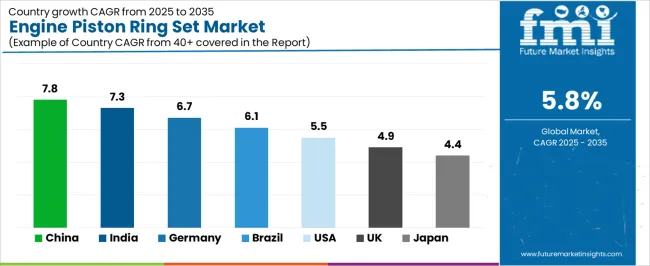
| Region/Country | 2025-2035 Growth | How to win | What to watch out |
|---|---|---|---|
| China | 7.8% | Focus on volume production solutions | Regulatory changes; local competition |
| India | 7.3% | Lead with cost-effective manufacturing | Import restrictions; quality barriers |
| Germany | 6.7% | Provide premium quality rings | Over-regulation; lengthy approvals |
| Brazil | 6.1% | Offer value-oriented solutions | Currency fluctuations; import duties |
| United States | 5.5% | Push technology integration | Compliance costs; scaling challenges |
| United Kingdom | 4.9% | Focus on premium applications | Economic impacts; component costs |
| Japan | 4.4% | Emphasize precision manufacturing | Traditional preferences; adoption rates |
China establishes fastest market growth through aggressive automotive development programs and comprehensive industrial engine expansion, integrating advanced piston ring systems as standard components in vehicle manufacturing and industrial installations. The country's 7.8% growth rate reflects government initiatives promoting automotive infrastructure and domestic manufacturing capabilities that mandate the use of advanced ring systems in automotive and industrial facilities. Growth concentrates in major manufacturing hubs, including Beijing, Shanghai, and Guangzhou, where automotive development showcases integrated ring systems that appeal to manufacturers seeking performance optimization capabilities and operational applications.
Chinese manufacturers are developing cost-effective ring solutions that combine domestic production advantages with advanced metallurgical features, including enhanced durability control and improved sealing capabilities. Distribution channels through automotive suppliers and component distributors expand market access, while government support for automotive development supports adoption across diverse vehicle and industrial segments.
Strategic Market Indicators:
In Mumbai, Delhi, and Bangalore, automotive facilities and industrial operators are implementing advanced piston ring systems as standard equipment for engine performance and operational optimization applications, driven by increasing government automotive investment and manufacturing modernization programs that emphasize the importance of component reliability capabilities. The market holds a 7.3% growth rate, supported by government automotive initiatives and industrial development programs that promote advanced ring systems for automotive and industrial facilities. Indian operators are adopting ring systems that provide consistent engine performance and durability features, particularly appealing in urban regions where vehicle performance and operational excellence represent critical business requirements.
Market expansion benefits from growing automotive capabilities and international manufacturing partnerships that enable domestic production of advanced ring systems for automotive and industrial applications. Technology adoption follows patterns established in automotive components, where reliability and performance drive procurement decisions and operational deployment.
Market Intelligence Brief:
Germany's advanced automotive market demonstrates sophisticated piston ring deployment with documented performance effectiveness in automotive applications and industrial facilities through integration with existing engine systems and manufacturing infrastructure. The country leverages engineering expertise in metallurgy and precision systems integration to maintain a 6.7% growth rate. Automotive centers, including Bavaria, Baden-Württemberg, and North Rhine-Westphalia, showcase premium installations where ring systems integrate with comprehensive engine platforms and facility management systems to optimize performance and operational effectiveness.
German manufacturers prioritize system quality and EU compliance in ring development, creating demand for premium systems with advanced features, including facility integration and performance monitoring systems. The market benefits from established automotive infrastructure and a willingness to invest in advanced ring technologies that provide long-term operational benefits and compliance with international automotive standards.
Market Intelligence Brief:
Brazil's market expansion benefits from diverse automotive demand, including manufacturing modernization in São Paulo and Rio de Janeiro, industrial facility upgrades, and government automotive programs that increasingly incorporate advanced ring solutions for engine applications. The country maintains a 6.1% growth rate, driven by rising automotive activity and increasing recognition of advanced ring benefits, including precise performance control and enhanced operational effectiveness.
Market dynamics focus on cost-effective ring solutions that balance engine performance with affordability considerations important to Brazilian automotive operators. Growing automotive industrialization creates continued demand for modern ring systems in new manufacturing infrastructure and facility modernization projects.
Strategic Market Considerations:
United States establishes market leadership through comprehensive automotive programs and advanced engine infrastructure development, integrating piston ring systems across automotive and industrial applications. The country's 5.5% growth rate reflects established automotive industry relationships and mature ring technology adoption that supports widespread use of advanced ring systems in automotive and industrial facilities. Growth concentrates in major automotive centers, including Michigan, Ohio, and Texas, where ring technology showcases mature deployment that appeals to manufacturers seeking proven performance capabilities and operational efficiency applications.
American automotive providers leverage established distribution networks and comprehensive technical support capabilities, including installation programs and training support that create customer relationships and operational advantages. The market benefits from mature regulatory standards and automotive requirements that mandate ring system use while supporting technology advancement and operational optimization.
Market Intelligence Brief:
United Kingdom's automotive market demonstrates integrated piston ring deployment with documented performance effectiveness in automotive applications and industrial facilities through integration with existing engine systems and manufacturing infrastructure. The country maintains a 4.9% growth rate, supported by automotive excellence programs and performance effectiveness requirements that promote advanced ring systems for automotive applications. Manufacturing facilities across England, Scotland, and Wales showcase systematic installations where ring systems integrate with comprehensive engine platforms to optimize performance and operational outcomes.
UK automotive providers prioritize system reliability and industry compatibility in ring procurement, creating demand for validated systems with proven performance features, including quality monitoring integration and performance optimization systems. The market benefits from established automotive infrastructure and excellence requirements that support ring technology adoption and operational effectiveness.
Market Intelligence Brief:
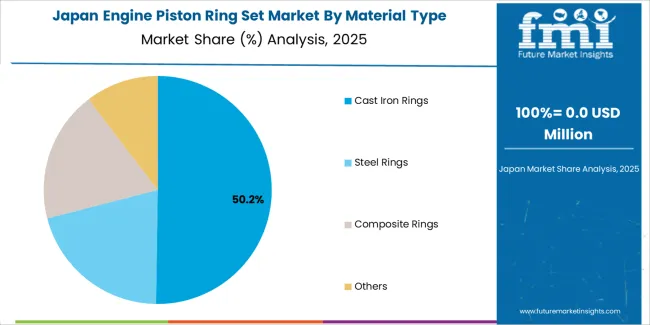
Japan's market growth benefits from precision automotive demand, including advanced manufacturing facilities in Tokyo and Osaka, quality integration, and performance enhancement programs that increasingly incorporate ring solutions for engine applications. The country maintains a 4.4% growth rate, driven by automotive technology advancement and increasing recognition of precision ring benefits, including accurate performance control and enhanced efficiency outcomes.
Market dynamics focus on high-precision ring solutions that meet Japanese quality standards and performance effectiveness requirements important to automotive operators. Advanced automotive technology adoption creates continued demand for sophisticated ring systems in manufacturing facility infrastructure and technology modernization projects.
Strategic Market Considerations:
The European engine piston ring set market is projected to grow from USD 151.2 million in 2025 to USD 255.8 million by 2035, registering a CAGR of 5.4% over the forecast period. Germany is expected to maintain its leadership position with a 41.3% market share in 2025, supported by its advanced automotive infrastructure and major manufacturing centers.
United Kingdom follows with a 22.8% share in 2025, driven by comprehensive automotive programs and engine excellence development initiatives. France holds a 16.4% share through specialized automotive applications and manufacturing compliance requirements. Italy commands a 11.7% share, while Spain accounts for 4.9% in 2025. The rest of Europe region is anticipated to gain momentum, expanding its collective share from 2.9% to 3.4% by 2035, attributed to increasing automotive adoption in Nordic countries and emerging manufacturing facilities implementing automotive modernization programs.
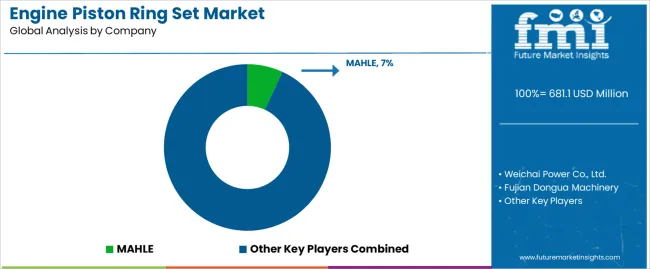
| Stakeholder | What they actually control | Typical strengths | Typical blind spots |
|---|---|---|---|
| Global brands | Distribution reach, broad product catalogs, brand recognition | Wide availability, proven quality, multi-region support | Product refresh cycles; customer dependency on brand validation |
| Technology innovators | Metallurgy R&D; advanced material technologies; enhanced performance properties | Latest technologies first; attractive ROI on performance effectiveness | Service density outside core regions; scaling complexity |
| Regional specialists | Local compliance, fast delivery, nearby customer support | "Close to customer" support; pragmatic pricing; local regulations | Technology gaps; talent retention in customer service |
| Full-service providers | Ring programs, installation services, performance monitoring | Lowest operational risk; comprehensive support | Service costs if overpromised; technology obsolescence |
| Niche specialists | Specialized applications, custom rings, performance services | Win premium applications; flexible configurations | Scalability limitations; narrow market focus |
| Item | Value |
|---|---|
| Quantitative Units | USD 681.1 million |
| Material Type | Cast Iron Rings, Steel Rings, Composite Rings, Others |
| Application | Automobile Engine, Ship Engine, Aerospace Engine, Others |
| End Use | Automotive Manufacturers, Marine Engine Producers, Aerospace Companies, Industrial Equipment Manufacturers, Aftermarket Suppliers |
| Regions Covered | North America, Latin America, Western Europe, Eastern Europe, East Asia, South Asia Pacific, Middle East & Africa |
| Countries Covered | China, India, Germany, Brazil, United States, United Kingdom, Japan, Canada, France, Australia, and 25+ additional countries |
| Key Companies Profiled | MAHLE, Weichai Power Co., Ltd., Fujian Dongua Machinery, Hastings, Riken, Total Seal, WELLFAR, C.T.I. Traffic Industries Co., Ltd., TPR Japan |
| Additional Attributes | Dollar sales by material type and application categories, regional adoption trends across East Asia, North America, and Western Europe, competitive landscape with metallurgy manufacturers and component suppliers, automotive operator preferences for ring effectiveness and engine performance, integration with engine platforms and performance management systems, innovations in metallurgical technology and ring enhancement, and development of advanced ring solutions with enhanced performance and operational optimization capabilities. |
The global engine piston ring set market is estimated to be valued at USD 681.1 million in 2025.
The market size for the engine piston ring set market is projected to reach USD 1,196.9 million by 2035.
The engine piston ring set market is expected to grow at a 5.8% CAGR between 2025 and 2035.
The key product types in engine piston ring set market are cast iron rings, steel rings, composite rings and others.
In terms of application, automobile engine segment to command 26.0% share in the engine piston ring set market in 2025.






Full Research Suite comprises of:
Market outlook & trends analysis
Interviews & case studies
Strategic recommendations
Vendor profiles & capabilities analysis
5-year forecasts
8 regions and 60+ country-level data splits
Market segment data splits
12 months of continuous data updates
DELIVERED AS:
PDF EXCEL ONLINE
Engine Cylinder Liners Market Size and Share Forecast Outlook 2025 to 2035
Engine Fogging Oil Market Size and Share Forecast Outlook 2025 to 2035
Engine Valve Market Size and Share Forecast Outlook 2025 to 2035
Engine Starter Fluid Market Growth - Demand, Trends & Forecast 2025 to 2035
Engineered Cell Therapy - Market Trends & Forecast 2025 to 2035
Engine Tuner Market - Growth & Demand 2025 to 2035
Engine Flush Market Growth – Trends & Forecast 2025-2035
Engineered Wood Market
Engine Actuators Market
Engine Mounting Brackets Market
Engineering Service Outsourcing Industry Analysis in North America Size and Share Forecast Outlook 2025 to 2035
Engineering Service Outsourcing Market Analysis - Size, Share, & Forecast Outlook 2025 to 2035
Engineering Analytics Market Growth & Demand 2025 to 2035
Engineering Plastic Market Analysis - Size, Share & Forecast 2025 to 2035
Geoengineering Market Analysis – Size, Demand & Forecast 2025 to 2035
Aeroengine Accessory Drive Train Market Size and Share Forecast Outlook 2025 to 2035
Gas Engines Market Size and Share Forecast Outlook 2025 to 2035
Aero Engine Coatings Market Growth - Trends & Forecast 2025 to 2035
Civil Engineering Market Size and Share Forecast Outlook 2025 to 2035
Tissue Engineered Skin Substitute Market Size and Share Forecast Outlook 2025 to 2035

Thank you!
You will receive an email from our Business Development Manager. Please be sure to check your SPAM/JUNK folder too.
Chat With
MaRIA